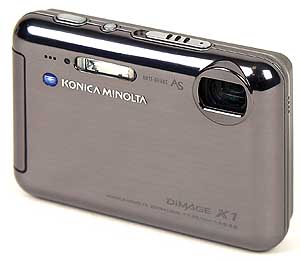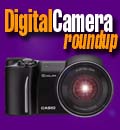
Compared to the square little metallic silver boxes that have ruled the ultra-compact/ultra-slim class from the start, the Konica Minolta DiMAGE X1 looks like a next-generation product. It sports a "soap bar" design rather then the boxy look, and while its body is metallic, its exterior looks more like two thin molded pieces of sheet metal stretched around whatever may be inside. The metal is very slightly brushed and has sort of a darkish look to it. The entire back is covered by a protective sheet of clear glass-like acrylic plastic that has a cutout only for the control module. It's certainly an interesting design, albeit one that looks perhaps a little bare and boring. It's also extremely prone to fingerprint smudges, to the extent where you'll want to give it a quick polish whenever you hand it over to someone else for inspection.
For a "next generation" design, the X1 also turned out to be surprisingly large. Its 3.7 x 2.7 inch footprint is the largest of the bunch, and even though the camera is fairly thin at 0.77 inches, it's the third most voluminous as well, right behind the Olympus and the portly HP. It doesn't weigh much, though--only 5.3 ounces--and that, combined with the rounded soap bar body, means it easily fits into most anyone's pocket.
Why didn't Konica Minolta make it smaller? Well, for one thing, this is a full 8 megapixel camera. That means a 1/1.8-inch CCD imager as opposed to the smaller 1/2.5 units of the 5-megapixel crowd. More importantly, though, like the two Sonys, the Samsung, and its DiMAGE X60 stablemate, the DiMAGE X1 has an entirely internal zoom. And the X1 also has a nice, large 2.5 inch display, albeit no optical viewfinder. So, overall, we would have liked this machine to be a little smaller.
As far as controls and ergonomics go, Konica Minolta chose an elegant, minimalist approach that works well. On top there's the on/off switch, a record mode slider (pictures, scenes, movies/audio). On the back you find a nicely designed, symmetrical control pod that contains just the zoom and a nav disc with four clearly marked buttons around it. Nothing else. The onscreen menu is equally clear and logical. Everything is in large text; none of the confusing mix of text and icons often found with the competition. With the slider set to scene mode, a different onscreen menu lets you select one of just seven modes (and those only have rather primitive icons).
The X1 is one of the few cameras in the lineup without any internal memory, and the package doesn't come with a starter SD Card, so make sure you buy one if you're new to digital photography.
Taking pictures with the DiMAGE couldn't be simpler. Konica Minolta is proud of the camera's new Anti-Shake feature. This is when you notice that the X1 provides additional information on its reflective acrylic backpane. It's a little bit like the dashboard in a car where information information shows up on an otherwise totally opaque background.
Compared to, say, the movie wizardry offered by the Casios, the Z1 sticks with the basics. You get your choice of 640x480 or 320x240 mode, but that's it. No special features, no zoom. Audio playback is weak. The movie mode slider position is shared with the voice recorder. You have to pick one or the other via menu--not an optimal solution. You can record voice until the card is full, but playback volume is very low. And speaking of voice, you can also add 15 second voice memos to pictures.
Like most others, the X1 comes with a dock, and that's the only way to connect to a computer or charge the battery. Not a direction we like.
Truth be told, we expected a bit more from the X1. It does have 8 megapixel and a nice internal zoom, but the camera is large and exceedingly basic.
The relatively large Minolta aced all our image quality tests, reaching the highest scores in the entire lineup. Pictures not only looked good, but also contained great detail even under large magnification. (Note: In January of 2006, Konica Minolta reported that, sadly, it will get out of the digital camera business.)
We like:
- Very good anti-shake feature
- Internal zoom and 8 megapixel resolution
- Ultra-clean controls and design
Not so much:
- Fairly large
- "Next-gen" design is smudge-prone
- Minimal feature set








